Thermohydraulic and irreversibility assessment of Power-law fluid flow within wedge shape channel
⁎Corresponding author. srehman34@gatech.edu (Sohail Rehman)
-
Received: ,
Accepted: ,
This article was originally published by Elsevier and was migrated to Scientific Scholar after the change of Publisher.
Peer review under responsibility of King Saud University.
Abstract
Entropy production occurs in all thermohydraulic systems, which results in performance degradation. Entropy production promotes irreversibility in complicated systems, which are commonly found in industrial mechanisms. As a response, this technology is successfully applied in several technological applications involving porous media, propulsion ducts, electronic cooling, turbomachinery, and combustion. In the current computational study, energy transfer and entropy development resulting from pressure-driven flow of a non-Newtonian fluid inside a wedge-shaped expanding channel is evaluated. The direct characterization of the inefficiency mechanisms that cannot be accomplished by the conventional energy analysis. Entropy generation analysis, which precisely quantifies the irreversibility resulting from heat transfer, mass transfer, and viscous heat loss of the Jaffrey-Hamel flow of power-law fluid. The conservation equations are used to develop the governing flow equations for the non-Newtonian Carreau fluid model. For the sake of the current investigation, the equation for entropy generation is modelled using the second law of thermodynamics. The appropriate transformations are implemented in order to convert the governing PDEs into a collection of coupled ODEs. To solve the generated extremely non-linear ODEs, the shooting approach and the fourth, fifth order Runge-Kutta method have been used. The acquired numerical statistics indicate that, while the thermal radiation parameter tends to increase the rate of heat transfer, the Eckert number decreases as it rises. For higher estimation of Weissenberg numbers and power law, the entropy number drops in a divergent channel, but a contrary tendency is revealed for Bejan profile. A growth in the power-law index leads to a significant reduction in several irreversibility. Moreover, entropy generation is lower within divergent channel in comparison to the convergent section. Heat and mass transport are substantially reduced as the power-law index rises.
Keywords
Irreversibility analysis
Wedge-shaped channel
Two-phase model
Power-law fluid
Nanofluid
Bejan profile
Nomenclature
-
-
Cylindrical coordinates
-
-
Fluid velocity (
-
-
Channel apex angle
-
-
Fluid maximum velocity (
-
-
Kinematic viscosity (
-
-
Fluid’s density (
-
-
Nanoparticles density (
-
-
Fluid heat capacity
-
-
Specific heat (
-
-
Fluid and wall temperature (K)
-
-
Fluid and wall concentration (
-
-
Reference temperature (
-
-
Reference concentration (
-
-
Generalized viscosity
-
-
Shear rate
-
-
Zero and infinite shear-rate viscosity
-
-
Material parameter of Carreau fluid
-
-
Power-law index of Carreau fluid
-
-
Cauchy stress tensor
-
-
Fluid pressure (Pa)
-
-
Pressure gradient
-
-
Stress tensor components
-
-
Thermophoresis diffusion coefficient
-
-
Brownian diffusion coefficient
-
-
Thermal conductivity
-
-
Mean absorption coefficient
-
-
Stephan-Boltzmann constant
-
-
Dimensionless angle
-
-
Dimensionless velocity
-
-
Dimensionless temperature
-
-
Dimensionless concentration
-
-
Thermophoresis parameter
-
-
Prandtl number
-
-
Reynold number
-
-
Weissenberg number
-
-
Radiation parameter
-
-
Brownian diffusion parameter
-
-
Skin-friction coefficient
-
-
Nusselt number
-
-
Sherwood number
-
-
Entropy generation rate
-
-
Dimensionless Bejan number
1 Introduction
Jeffery-Hamel flows have a variety of uses in contemporary physical phenomena, including river and canal exploration, fluid mechanics, aerodynamics, civil, biomechanical, mechanical, and chemical engineering. The flow through rivers, canals, and other biological flows, such as the flow within arteries and venous blood vessels, are the best examples of practical applications for these types of flows. Over the past four decades, non-Newtonian fluid dynamic interactions within surfaces (such as planes, channels, tubes, and wedges) and various kinds of fluid have been studied. (Jeffery, 1915) and (Hamel, 1917) initiated the study of such flows above a century ago by reducing the Naiver–Stokes equations. They inspected heat transference of viscous Newtonian flow in a channel within non-parallel walls, which has subsequently known as Jeffery–Hamel flow. (W, 1931), and (R, 1934) focused on this flow problem following the preliminary analysis of Jeffery and Hamel. A comprehensive set of mathematical solution for this problem was subsequently provided by (Rosenhead and Taylor, 1940). (Fraenkel and Squire, 1962) elaborated on this and established a solution for the 2D Navier-Stokes equations for flow in a channel, their findings revealed that the creation of a boundary layer and a zone of flow reversal. After that, (Mansutti and Ramgopal, 1991) performed numerical analysis to investigate the convergent and divergent flow of a power-law fluid and discovered a solution that allowed boundary layers to exist even in the non-inertial flow between divergent planes. (Nagler, 2017) extend the J-H flow to non-Newtonian fluid considering non-linear viscosity and friction at the channel wall. The analysis of (Mansutti and Ramgopal, 1991) was expanded by (Harley et al., 2018) to include a power-law fluid whose rest viscosity is neither zero nor infinite for any finite value of the power-law exponent. They noted boundary layers for the non-Newtonian fluid even in divergent flow and at approximately zero Reynolds number (
Substantial technological developments in electronics and micro devices industries introduce promising elucidations for thermal sink challenges. In the designing process of thermal devices, energy effectiveness is a key concern. This concern can be suitably tackled by the reduction of the entropy generation phenomenon. Energy changes is a natural phenomenon besides an external source is applied. No authentic variation for entropy has ascended if such mechanism is related to the investigation of second law under an irreversible process. This heatline phenomenon is very familiar amongst the recent scientist and researchers due to its potential consequences in heat transport processes. As a result, entropy generation minimization is now extensively monitored throughout in engineering and the manufacturing sectors, for instance, in nuclear power plants, thermal reactors, and petroleum and geothermal reservoirs. The irreversibility of an remote system that experiences fluid friction, thermal and solute transport, molecular vibration, thermal radiation, the Joule Thompson effect, and other non-ideal processes can be estimated via entropy optimization. It is common knowledge that reducing entropy rate is important to increase efficiency of an isolated closed system, especially in power plants, heat exchangers, fuel cells, geothermal energy systems, engineering phenomena, thermal storage, and advanced nanotechnology. (Bejan, 1979), (Bejan and Kestin, 1983) came up with innovative work exploring entropy generation concept. The second law was implemented to the problem of thermal transmission in metallic porous channels was addressed by (Turkyilmazoglu, 2020). (Nayak et al., 2021) reported on the entropy production in electromagnetic nanofluid flow under cubic auto-catalysis reaction. Some important studies about this topic are highlighted in Refs. (Hayat et al., 2017), (Das et al., 2018b), (Das et al., 2018a), (Chu et al., 2020), (Das et al., 2020), (Sarkar et al., 2020), (Shehzad et al., 2021), (Madhu et al., 2021), (Mahanthesh et al., 2021), (Madhu et al., 2022), (Ali et al., 2022), (Xu et al., 2022),.
It is an established fact that the complicated interaction between shear and strain rates prevents Navier Stokes equations from accurately describing the properties of non-Newtonian liquids. Experimental measurements show that non-Newtonian fluids respond differently to the application of shear stress in terms of strain rate. Non-Newtonian liquids are divided into shear thinning and thickening liquids based on this relationship. The importance of non-Newtonian fluids in several engineering, technological, and everyday life activities has increased because of these classifications. A variety of fluid models are offered to better illustrate the physical interpretation of these fluids. These models include the flow characteristics of shear thinning and thickening liquids including Carreau fluid. Carreau model has a wide range of application in the production of polymers, capillary electrophoresis, crystal development, mud drilling, the manufacture of gels and shampoos, powder technology, and biological applications. To understand the rheological behavior of shear thinning fluids, numerous mathematical models have been used in literature. (Ostwald, 1929) model was the first to show the straightforward relationship between shear stress and shear rate. Even so, this version eventually turned to serve as the basis for a variety of viscometers and rheometers that collect rheological data on a variety of fluids that are shear thinning. Technically speaking, the so-called “power law” model is not able to forecast how shear-thinning fluids will behave at extremes of shear rate. Later on, (Cross, 1965) proposed another mathematical formula to assess the rheological behavior of fluids that were shear thinning. When it comes to estimating rheological properties at low and high shear rate values, this model and power-law model are better enough. (Carreau, 1972) offered a concept on the fundamental molecular makeup of a fluid that was shear-thinning. The five factors in this model are used to forecast viscosity behavior. The generalized model is identified as:
This investigation work reports the consequences of irreversibility mechanism with second law utilization in Carreau non-Newtonian fluid flow generated within an inclined channel. The innovation of this research is studying the heat transfer, mass transfer, and viscous heating irreversibility of the wedge configuration. The fluid flows in channel have abundant effects in distinctive features like refrigeration, automotive, heat exchangers and aerospace industries. Energy transport mechanism is elucidated by the implications of radiative heat flux and viscous heating phenomenon. System irreversibility are precisely quantified in this work using an entropy generation analysis based on a new multi-scale coupled model. The coupled model includes a two-dimensional (2-D) power-law model, a two-dimensional (2-D) thermal model, and a local entropy generation rate model that account for a comprehensive solution of the flow, mass concentration, heat transfer, and entropy generation rate equations. Entropy creation mechanisms linked to heat transfer, mass transfer, and frictional entropy generation. The study's originality and worth may be determined by the fact that it provides novel and previously unreported treatments of the Carreau nanofluids in intersecting plate with plane walls assuming purely radial flow. The fourth-order R-K technique is used with the shooting strategy to provide the numerical simulation of transformed leading equations. Graphical illustrations are provided of the effects of encoded parameters on the velocity, temperature, nanoparticle concentration, and system irreversibility profiles for the flow models. The outcomes of physically fascinating quantities are explained using the various physical constraint values. According to physical background and characteristics, these outcomes are explored in detail. The study will be helpful and novel for industries and academic institutions researching entropy minimization in channel flows.
2 Modelling framework
2.1 Problem statement and underlying assumptions
This section addresses a mathematical treatment of the physical problem. The laminar, incompressible flow of non-Newtonian fluid from a source or sink located at the channel apex as displayed in Fig. 1.
-
The flow is assumed in cylindrical coordinates
-
Assume that only radial motion affects the flow parameter.
-
Assuming that the two rigid, non-parallel plane walls are taken at an angle of
-
The flow of a non-Newtonian fluid inside a converging divergent wedge originates from a source and driven by a constant pressure gradient.
-
It is assumed that
-
The walls of the channel are isothermal i.e., no heat exchange occur between fluid and the channel walls.
-
The conservation of energy equation is constructed using traditional Fourier-law coupled with Buongiorno model and viscous heat mechanism.
-
The entropy generations equation is derived in term of velocity, heat energy and dissipations.

- Power-law wedge shape flow model and coordinate system.
In radial coordinates the 2-D the field of velocity, temperature, concentration, and Cauchy stress tensor between intersecting rough plates for Carreau fluid are settled as.
2.2 Mathematical analysis
The conservation of mass, momentum equation for non-Newtonian fluid is written as:
Where
The shear stress tensor
where
The stresses components in view of Eq. (2), (5) and (7), we have
The continuity and Navier-Stokes equations in component form are summarized as follows for the two-dimensional flow (Ahmad et al., 2021), (Garimella et al., 2022), (Ramesh et al., 2022)
Applying Eq. (5), into Eqs. (7), and (8), we have
2.3 Thermal analysis
The heat transfer equation for the current problem while taking the combined contributions of the viscous dissipation, thermal radiation effect, and Buongiorno's model (Owhaib and Al-Kouz, 2022), (Chu et al., 2021)
In above Eq. (13),
By invoking Eq. (14) in Eq. (13), the energy conservation equation reduces to (Krishna et al., 2019), (Krishna et al., 2020), (Krishna et al., 2018)
2.4 Mass concentration equation
The nanoparticles concentration via Buongiorno model is written as:
2.5 Boundary conditions
The governing boundary conditions for the flow model are (Khan et al., 2015), (Saif and Jasim, 2019):
At the center of channel:
At the channel walls:
2.6 Normalization mechanism
Introducing similarity variables to normalize the governing equations (Khan et al., 2015), (Al-Saif and Jasim, 2019), (Bhaskar et al., 2022)
The converted system of governing ODEs become:
with reduced conditions:
The reduced parameters are:
2.7 Entropy mechanism and Bejan analysis
Within the context of the to the second law of thermodynamics the current investigation, for entropy generation which measure the heat sink performance is focused in this communication. Entropy generation in this context is divided into three categories: heat, mass, and frictional entropy generation. The transmitted heat often causes thermal entropy generation (TEG). On the other side, the irreversibility caused by viscous effects during the flow is referred to as frictional entropy formation (FEG). According to these definitions, it is anticipated that TEG and FEG rates will differ greatly depending on the type of fluid used as well as how the morphologies of the nanoparticles in the nanofluid are taken into account. Because these parameters have a significant impact on the flow structure and heat transfer characteristics, which also has an impact on the generated entropy. The totoal rate of entropy generation is obtained by adding the thermal and frictional components of entropy generation. However, energy destruction or created entropy are the main causes of low-efficiency systems. The total entropy generation rate
Where
In coordinates system the above equation can be settled as
The normalized entropy generation equation in the context of similarity variables reduces to
Here
Bejan number
The range of the Bejan number is restricted to
2.8 Curiosity in engineering parameters
Skin drag force.
The skin drag-force i.e., the skin friction for Carreau fluid is
Where
Thus, the dimensionless expression become
Heat transfer rate
The local Nusselt Number is demarcated as:
Where
Employing the dimensionless variables, we get
Mass transfer rate
The local Sherwood Number is interpreted as:
Where
Thus
3 Numerical scheme for solution
The shooting method, a well-known numerical methodology, is implemented to numerically solve the governing problem. In order to find the values of
The fourth order Runge–Kutta component is denoted by
The step size is
3.1 Results validation
We compare the current numerical values for velocity field
|
|
|
|
||
|---|---|---|---|---|
| (Sari et al., 2016) | Present results | (Sari et al., 2016) | Present results | |
| −1 | 0 | 0 | 0 | 0 |
| −0.75 | 0.346178919 | 0.34175932 | 0.956861924 | 0.95862988 |
| −0.5 | 0.669320174 | 0.66929111 | 0.811457376 | 0.81146278 |
| -0.25 | 0.909765342 | 0.90978112 | 0.515827995 | 0.51582911 |
| 0.0 | 1 | 1 | 1 | 1 |
| 0.25 | 0.909765342 | 0.90980111 | 0.515827995 | 0.51579910 |
| 0.5 | 0.669320174 | 0.66931012 | 0.811457376 | 0.81145017 |
| 0.75 | 0.346178916 | 0.34617239 | 0.956861924 | 0.95890181 |
| 1.0 | 0 | 0 | 0 | 0 |
4 Declaration of result and discussion
This segment focused on examining how various values of the relevant parameter behaved in comparison to the distributions of velocity, temperature, concentration, irreversibility mechanism. All drawings show the effects of various values in two distinct scenarios: the first is a fluid entering a channel that is converging, and the second involves a fluid exiting a channel that is diverging.
4.1 Flow dynamics within wedge configuration
The fluctuation of velocity profile
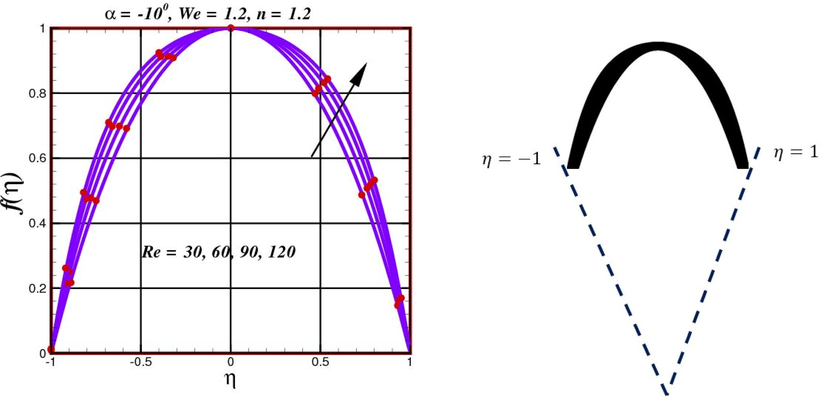
- Performance of velocity
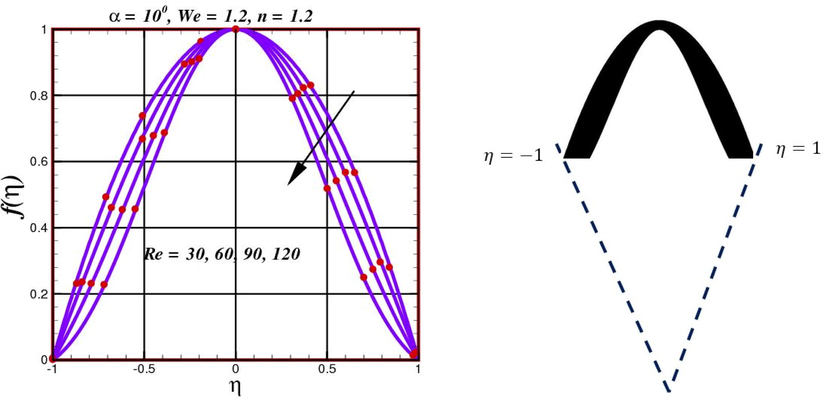
- Performance of velocity

- Performance of velocity

- Performance of velocity
4.2 Thermal distribution phenomena
The flow and temperature phenomena are combined with each other in the case of viscous heating. Consequently, the flow pattern inside the wedge, debated in the subsection, will significantly influence the corresponding temperature phenomena. In this subsection, we have deliberated the heat transfer features in detail in terms of the non-dimensional temperature distribution. The effect of the Weissenberg number (

- Behavior of temperature
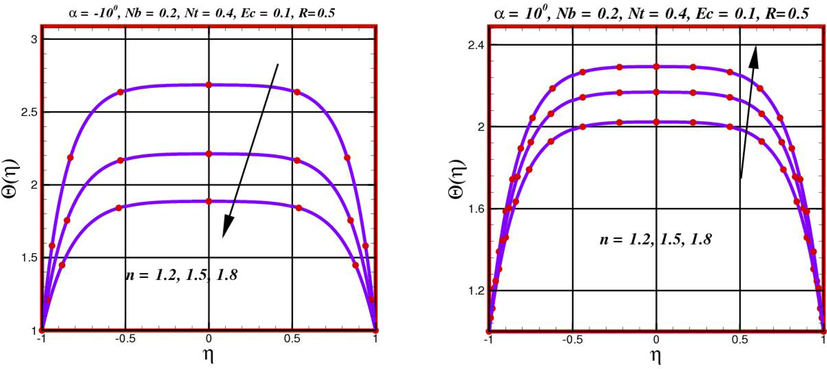
- Behavior of temperature
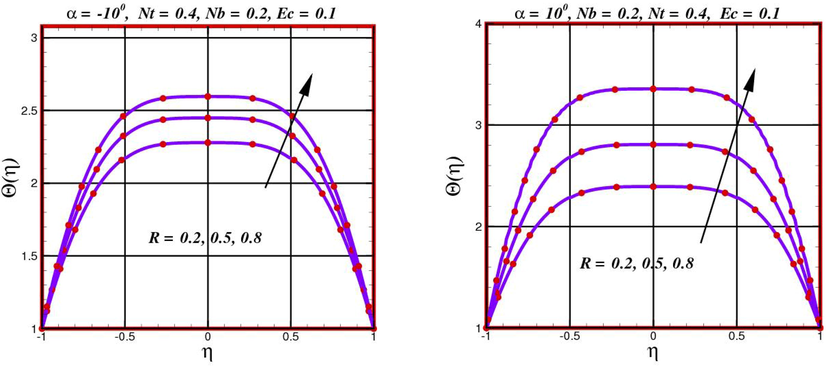
- Behavior of temperature
4.3 Concentration profile
The concentration profile inside the wedge shape channel at various Weissenberg values is exposed in Fig. 9. There is no mixing of the fluids with low Weissenberg numbers. The middle of the diverging channel where the fluid mingles the most, as the Weissenberg number rises to
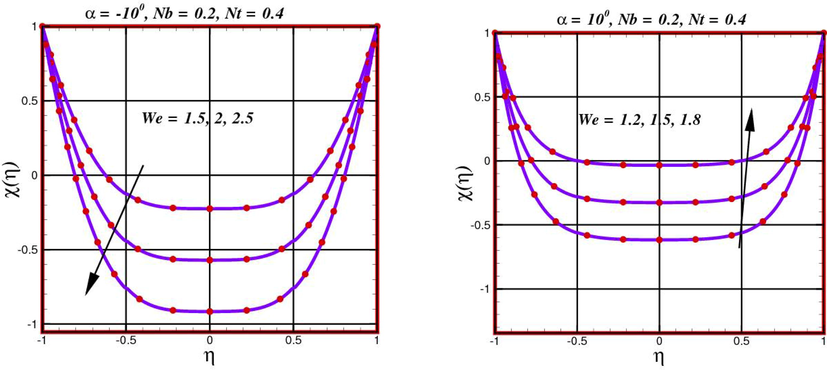
- Behavior of concentration
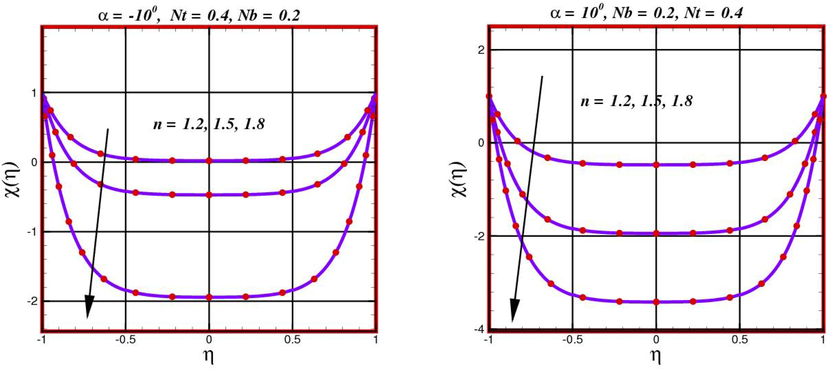
- Behavior of concentration
4.4 Irreversibility analysis of Power-Law fluid
In this section, entropy-generation rate
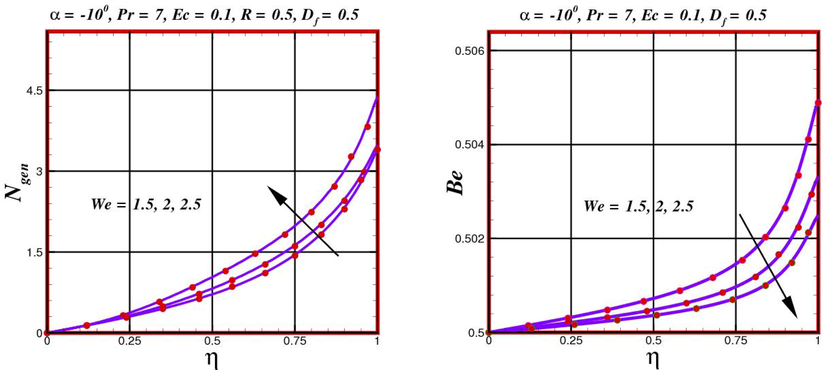
- Distribution of entropy generation rate
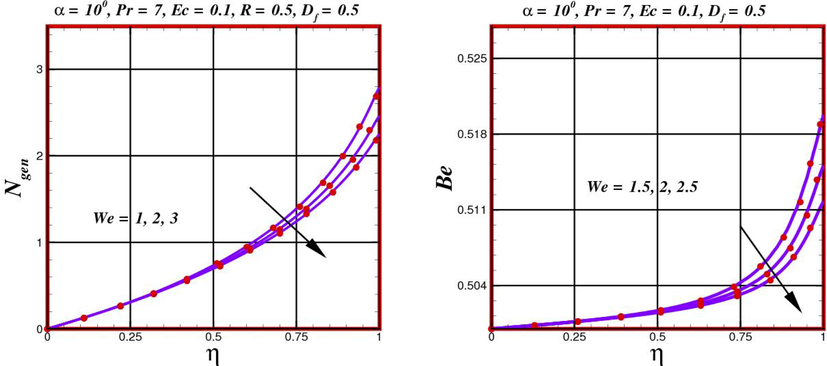
- Distribution of entropy generation rate
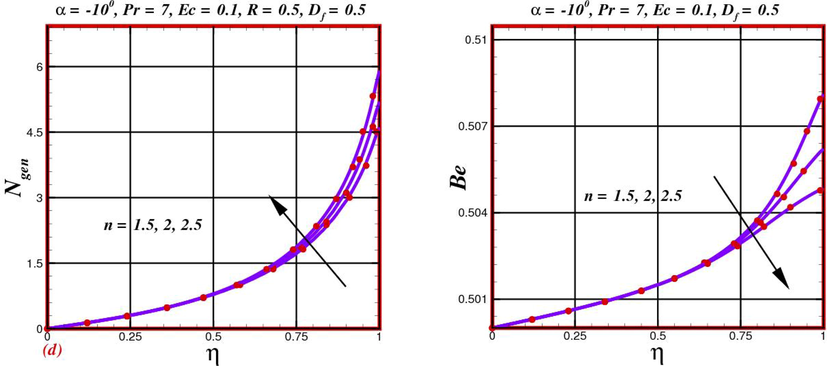
- Distribution of entropy generation rate

- Distribution of entropy generation rate
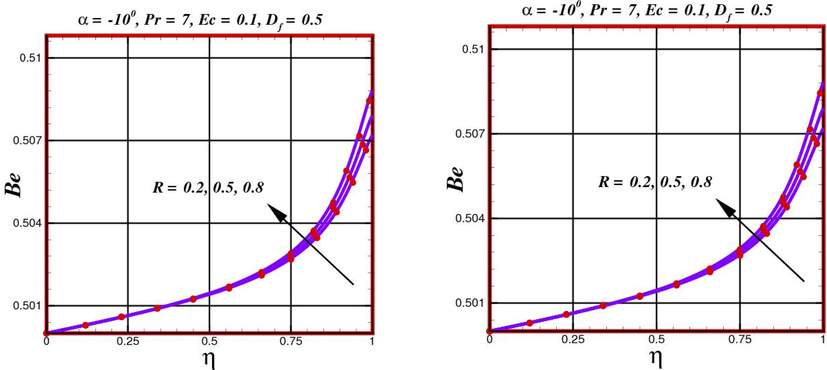
- Distribution of entropy generation rate
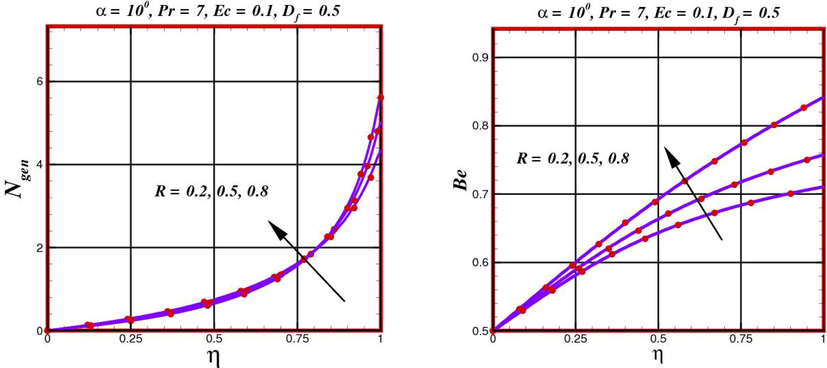
- Distribution of entropy generation rate
4.5 Quantities of physical interest
Tables 2 and 3 illustrates the effects of physical flow parameter on the rate of mass and heat transmission in the converging and diverging channel. Additionally, a comparison of the outcomes for both geometries are included. From these table, one can infer that as the Eckert number
|
|
|
|
|
|
|
|
|
|
|---|---|---|---|---|---|---|---|---|
| 7 | 0.4 | 0.2 | 0.1 | 1.0 | 1.1 | 0.1 | −0.3980 | 0.2388 |
| 0.6 | −0.3980 | 0.1592 | ||||||
| 0.8 | −0.3980 | 0.1194 | ||||||
| 7 | 0.4 | 0.2 | 0.1 | 1.0 | 1.1 | 0.1 | −0.3980 | 0.2388 |
| 0.6 | −0.3924 | 0.4708 | ||||||
| 0.8 | −0.3869 | 0.6965 | ||||||
| 7 | 0.4 | 0.2 | 0.1 | 1.0 | 1.1 | 0.1 | −0.7847 | 0.9160 |
| 0.2 | −1.1608 | 0.4708 | ||||||
| 0.3 | −1.5266 | 0.6965 | ||||||
| 7 | 0.4 | 0.2 | 0.1 | 1.0 | 1.1 | 0.1 | −0.7965 | 0.4779 |
| 1.2 | −0.8195 | 0.4917 | ||||||
| 1.3 | −0.8417 | 0.5050 | ||||||
| 7 | 0.4 | 0.2 | 0.1 | 1.0 | 1.1 | 0.1 | −0.7847 | 0.4708 |
| 1.2 | −0.8816 | 0.5290 | ||||||
| 1.3 | −0.9930 | 0.5958 | ||||||
| 7 | 0.4 | 0.2 | 0.1 | 1.0 | 1.1 | 0.1 | −0.3980 | 0.9160 |
| 0.2 | −0.3974 | 0.9164 | ||||||
| 0.3 | −0.3969 | 0.9160 |
|
|
|
|
|
|
|
|
|
|
|---|---|---|---|---|---|---|---|---|
| 7 | 0.4 | 0.2 | 0.1 | 1.0 | 1.1 | 0.1 | −1.7695 | 0.8847 |
| 0.6 | −1.7695 | 0.5898 | ||||||
| 0.8 | −1.7695 | 0.4424 | ||||||
| 7 | 0.4 | 0.2 | 0.1 | 1.0 | 1.1 | 0.1 | −1.7695 | 0.9069 |
| 0.6 | −1.8137 | 1.8137 | ||||||
| 0.8 | −1.8139 | 2.7209 | ||||||
| 7 | 0.4 | 0.2 | 0.1 | 1.0 | 1.1 | 0.1 | −0.9069 | 0.4534 |
| 0.2 | −1.8137 | 0.9069 | ||||||
| 0.3 | −1.8139 | 1.3603 | ||||||
| 7 | 0.4 | 0.2 | 0.1 | 1.0 | 1.1 | 0.1 | −0.9069 | 0.4479 |
| 1.2 | −1.8137 | 0.4694 | ||||||
| 1.3 | −2.7206 | 0.5050 | ||||||
| 7 | 0.4 | 0.2 | 0.1 | 1.0 | 1.1 | 0.1 | −0.8958 | 0.4730 |
| 1.2 | −0.9177 | 0.5290 | ||||||
| 1.3 | −0.9388 | 0.5931 | ||||||
| 7 | 0.4 | 0.2 | 0.1 | 1.0 | 1.1 | 0.1 | −1.7695 | 0.9069 |
| 0.2 | −1.8690 | 0.9083 | ||||||
| 0.3 | −1.9645 | 0.9097 |
5 Conclusion
In this theoretical communication, an entropy generation analysis of the Carreau fluid in a Wedge shape convergent divergent channel geometry with different parameter is securitized for the first time to estimate the effects of thermodynamic irreversibility. The Carreau fluid is significant in chemical engineering and polymeric suspensions because it combines the power-law and Newtonian fluid models. The Carreau fluid model can be used to describe the properties of paints, polymer fluids, polyvinyl chloride, and polyethylene. The second law of thermodynamics is used to estimate the local entropy generation rate, which is used to identify irreversibility processes and quantify thermodynamic irreversibility that occur in wedge-shaped channels. In the entropy generation model, the contributions of the power-index
6 Future recommendation
The model can be extended to design approach prioritizing heat transmission effectiveness for two-dimensional convergent–divergent rocket nozzle will be more appropriate to reduce exergy destruction for more practical problem. Applying magnetic effects offers extra opportunities for design and heat transfer mechanism optimization. Indeed, magnetic fields and lubricated walls outcome in a very efficient method to condense entropy generation although they degrade heat transfer efficiency. Therefore, combined effect of magnetic field and radiation effects they could offer brilliant equilibrium between heat transfer productivity and exergy destruction.
Acknowledgement
The authors extend their appreciation to the Deanship of Scientific Research at King Khalid University for funding this work through Large Groups Project under grant number (RGP.2/25/43).
Declaration of Competing Interest
The authors declare that they have no known competing financial interests or personal relationships that could have appeared to influence the work reported in this paper.
References
- Entropy generation analysis for magnetized peristaltic movement of nanofluid through a non-uniform asymmetric channel with variable thermal conductivity. Chin. J. Phys.. 2022;78:111-131.
- [CrossRef] [Google Scholar]
- Computational modeling and analysis for the effect of magnetic field on rotating stretched disk flow with heat transfer. Propul. Power Res.. 2021;10:48-57.
- [CrossRef] [Google Scholar]
- A report on entropy generation and Arrhenius kinetics in magneto-bioconvective flow of Cross nanofluid over a cylinder with wall slip. Int. J. Ambient Energy 2022:1-16.
- [CrossRef] [Google Scholar]
- New analytical study of the effects thermo-diffusion, diffusion-thermo and chemical reaction of viscous fluid on magneto hydrodynamics flow in divergent and convergent channels. Appl. Math.. 2019;10:268-300.
- [CrossRef] [Google Scholar]
- Numerical study of boundary stresses on Jeffery-Hamel flow subject to Soret/Dufour effects. Proc. Inst. Mech. Eng. C J. Mech. Eng. Sci.. 2022;09544062221126646
- [CrossRef] [Google Scholar]
- Numerical study of self-similar natural convection mass transfer from a rotating cone in anisotropic porous media with Stefan blowing and Navier slip. Indian J Phys. 2020;94:863-877.
- [CrossRef] [Google Scholar]
- Entropy generation minimization: The new thermodynamics of finite-size devices and finite-time processes. J. Appl. Phys.. 1996;79:1191-1218.
- [CrossRef] [Google Scholar]
- A Study of Entropy Generation in Fundamental Convective Heat Transfer. J. Heat Transfer. 1979;101:718-725.
- [CrossRef] [Google Scholar]
- Entropy Generation Through Heat and Fluid Flow. J. Appl. Mech.. 1983;50:475.
- [CrossRef] [Google Scholar]
- Cross-diffusion and chemical reaction effects of a MHD nanofluid flow inside a divergent/convergent channel with heat source/sink. J. Therm. Anal. Calorim. 2022
- [CrossRef] [Google Scholar]
- A comprehensive physical insight about thermo physical aspects of Carreau fluid flow over a rotated disk of variable thickness by implementing finite difference approach. Propul. Power Res.. 2022;11:143-153.
- [CrossRef] [Google Scholar]
- Rheological equations from molecular network theories. Trans. Soc. Rheol.. 1972;16:99-127.
- [CrossRef] [Google Scholar]
- Entropy generation minimization for CO2 hydrogenation to light olefins. Energy. 2018;147:187-196.
- [CrossRef] [Google Scholar]
- Study of Buongiorno’s nanofluid model for flow due to stretching disks in presence of gyrotactic microorganisms. Ain Shams Eng. J.. 2021;12:3975-3985.
- [CrossRef] [Google Scholar]
- Cattaneo-Christov double diffusions (CCDD) in entropy optimized magnetized second grade nanofluid with variable thermal conductivity and mass diffusivity. J. Mater. Res. Technol.. 2020;9:13977-13987.
- [CrossRef] [Google Scholar]
- Rheology of non-Newtonian fluids: a new flow equation for pseudoplastic systems. J. Colloid Sci.. 1965;20:417-437.
- [CrossRef] [Google Scholar]
- Entropy analysis of MHD variable thermal conductivity fluid flow past a convectively heated stretching cylinder. Defect and Diffusion Forum. 2018;387:244-259.
- [CrossRef] [Google Scholar]
- Feature of entropy generation in Cu-Al2O3/Ethylene glycol hybrid nanofluid flow through a rotating channel. BioNanoSci.. 2020;10:950-967.
- [CrossRef] [Google Scholar]
- Entropy generation analysis of MHD Slip Flow of Non-Newtonian Cu-Casson nanofluid in a porous microchannel filled with saturated porous medium considering thermal radiation. J. Nanofluids. 2018;7:1217-1232.
- [CrossRef] [Google Scholar]
- Laminar flow in symmetrical channels with slightly curved walls, I. On the Jeffery-Hamel solutions for flow between plane walls. Proc. Roy. Soc. London. Ser. A. Math. Phys. Sci.. 1962;267:119-138.
- [CrossRef] [Google Scholar]
- Jeffery-Hamel flow of a shear-thinning fluid that mimics the response of viscoplastic materials. Int. J. Non Linear Mech.. 2022;144:104084
- [CrossRef] [Google Scholar]
- Spiralförmige Bewegungen zäher Flüssigkeiten. Jahresber. Deutsch. Math.-Verein.. 1917;25:34-60.
- [Google Scholar]
- Reversal of flow of a non-Newtonian fluid in an expanding channel. Int. J. Non Linear Mech.. 2018;101:44-55.
- [CrossRef] [Google Scholar]
- Thermal energy and mass transport of shear thinning fluid under effects of low to high shear rate viscosity. Int. J. Thermofluids. 2022;15:100176
- [CrossRef] [Google Scholar]
- Modeling MHD Stagnation Point Flow of Thixotropic Fluid with Non-uniform Heat Absorption/Generation. Microgravity Sci. Technol.. 2017;29
- [CrossRef] [Google Scholar]
- Adaptive simulations to pressure distribution for creeping motion of Carreau nanofluid with variable fluid density effects: physiological applications. Thermal Sci. Eng. Prog.. 2022;32:101337
- [CrossRef] [Google Scholar]
- L. The two-dimensional steady motion of a viscous fluid. The London, Edinburgh, and Dublin Philosophical Magazine J. Sci.. 1915;29:455-465.
- [CrossRef] [Google Scholar]
- Numerical outlook of a viscoelastic nanofluid in an inclined channel via Keller box method. Int. Commun. Heat Mass Transfer. 2022;137:106260
- [CrossRef] [Google Scholar]
- On multiple solutions of non-Newtonian Carreau fluid flow over an inclined shrinking sheet. Results Phys.. 2018;8:926-932.
- [CrossRef] [Google Scholar]
- Thermo-diffusion, diffusion-thermo and chemical reaction effects on MHD flow of viscous fluid in divergent and convergent channels. Chem. Eng. Sci.. 2015;141
- [CrossRef] [Google Scholar]
- Heat and mass transfer on mhd flow of second-grade fluid through porous medium over a semi-infinite vertical stretching sheet. JPM. 2020;23
- [CrossRef] [Google Scholar]
- HEAT and mass transfer on unsteady, magnetohydrodynamic, oscillatory flow of second-grade fluid through a porous medium between two vertical plates, under the influence of fluctuating heat source/sink and chemical reactioN. FMR. 2018;45
- [CrossRef] [Google Scholar]
- Investigations of Soret, Joule and Hall effects on MHD rotating mixed convective flow past an infinite vertical porous plate. J. Ocean. Eng. Sci.. 2019;4:263-275.
- [CrossRef] [Google Scholar]
- Thermal analysis of MHD Powell-Eyring fluid flow through a vertical microchannel. Int. J. Ambient Energy. 2022;43:4454-4462.
- [CrossRef] [Google Scholar]
- Second law analysis of MHD micropolar fluid flow through a porous microchannel with multiple slip and convective boundary conditions. Defect Diffusion Forum. 2021;409:123-141.
- [CrossRef] [Google Scholar]
- Heat transfer optimization of hybrid nanomaterial using modified Buongiorno model: a sensitivity analysis. Int. J. Heat Mass Transf.. 2021;171:121081
- [CrossRef] [Google Scholar]
- On inherent irreversibility in a reactive hydromagnetic channel flow. J. Therm. Sci.. 2010;19:72-79.
- [CrossRef] [Google Scholar]
- Flow of a shear thinning fluid between intersecting planes. Int. J. Non Linear Mech.. 1991;26:769-775.
- [CrossRef] [Google Scholar]
- Jeffery-Hamel flow of non-Newtonian fluid with nonlinear viscosity and wall friction. Appl. Math. Mech.-Engl. Ed.. 2017;38:815-830.
- [CrossRef] [Google Scholar]
- Electromagnetic flow of SWCNT/MWCNT suspensions with optimized entropy generation and cubic auto catalysis chemical reaction. Int. Commun. Heat Mass Transfer. 2021;120:104996
- [CrossRef] [Google Scholar]
- Ueber die rechnerische Darstellung des Strukturgebietes der Viskosität. Kolloid-Zeitschrift. 1929;47:176-187.
- [CrossRef] [Google Scholar]
- Three-dimensional numerical analysis of flow and heat transfer of bi-directional stretched nanofluid film exposed to an exponential heat generation using modified Buongiorno model. Sci. Rep.. 2022;12:10060.
- [CrossRef] [Google Scholar]
- Ternary nanofluid with heat source/sink and porous medium effects in stretchable convergent/divergent channel. Proc. Institution Mech. Engineers, Part E: J. Process Mech. Eng.. 2022;09544089221081344
- [CrossRef] [Google Scholar]
- A group theoretic analysis on heat transfer in MHD thermally slip Carreau fluid subject to multiple flow regimes (MFRs) Case Stud. Thermal Eng.. 2022;30:101787
- [CrossRef] [Google Scholar]
- The steady two-dimensional radial flow of viscous fluid between two inclined plane walls. Proc. R. Soc. Lond. A. 1940;175:436-467.
- [CrossRef] [Google Scholar]
- Heat transfer of copper/water nanofluid flow through converging-diverging channel. J. Cent. South Univ.. 2016;23:484-496.
- [CrossRef] [Google Scholar]
- Activation energy impact on radiated magneto-Sisko nanofluid flow over a stretching and slipping cylinder: entropy analysis. Multidiscip. Model. Mater. Struct.. 2020;16:1085-1115.
- [CrossRef] [Google Scholar]
- Finite element analysis of micropolar nanofluid flow through an inclined microchannel with thermal radiation. Multidiscip. Model. Mater. Struct.. 2020;16:1521-1538.
- [CrossRef] [Google Scholar]
- Thermal and entropy generation of non-Newtonian magneto-Carreau fluid flow in microchannel. J. Therm Anal. Calorim.. 2021;143:2717-2727.
- [CrossRef] [Google Scholar]
- Second law thermodynamic analysis of thermo-magnetic Jeffery-Hamel dissipative radiative hybrid nanofluid slip flow: existence of multiple solutions. Eur. Phys. J. Plus. 2020;135:849.
- [CrossRef] [Google Scholar]
- Velocity Slip and Entropy Generation Phenomena in Thermal Transport Through Metallic Porous Channel. J. Non-Equilib. Thermodyn.. 2020;45:247-256.
- [CrossRef] [Google Scholar]
- Hall and ion slip impacts on unsteady MHD free convective rotating flow of Jeffreys fluid with ramped wall temperature. Int. Commun. Heat Mass Transfer. 2020;119:104927
- [CrossRef] [Google Scholar]
- Similarity solutions of the entropy transport equation. Int. J. Thermal Sci.. 2009;48:1863-1869.
- [CrossRef] [Google Scholar]
- New modeling and analytical solution of fourth grade (non-Newtonian) fluid by a stretchable magnetized Riga device. Int. J. Mod. Phys. C. 2022;33:2250013.
- [CrossRef] [Google Scholar]







